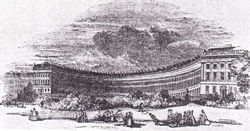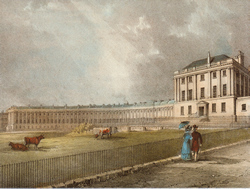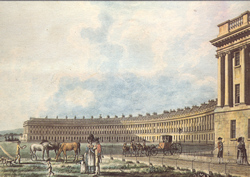|
||
|
|
||
|
Home |
General Information |
Gallery &
Reference |
History
|
News
& Events |
Community
|
Contact Us |
||
|
|
| Crescent History | Crescent Lawn History | Bath History | Literary Bath | Bath at War| What If? |
| Royal
Crescent History
As with much of Bath’s development during the 18th Century, the Royal Crescent was a speculative, entrepreneurial and commercial venture, which produced a masterpiece of architecture and urban design. After his father died, John Wood the Younger wanted, as an architect, to continue his father’s unfinished legacy in terms of grand design, the now fashionable Palladian style and Masonic symbolism. As an entrepreneur, he wanted also to emulate his father in successfully catering not only to the nobility, but also to the newly emerging middle class. This was a new social group of people who, though mostly lacking the highest status or title were sufficiently affluent to have no need to work with their hands and to be able to indulge their increasing desire to enjoy the lifestyle of their social superiors. They may not have always been able to afford the fine country mansions with large grounds, but they could afford and sought fairly large town-houses in fashionable cities like Bath when they were presented, as the Woods and others so cleverly did, as palaces, or grand terraces. This concept is evident all over Bath. John Wood the Elder’s North side of Queen Square, Milsom Street, Kensington Place, St.James’ Square and other streets display the trick beautifully. Most have a pediment over the central house or houses, which, as well as the two end houses, is set slightly forward – giving the impression of a sort of vestigial Blenheim. The grandest of all the “palaces” is the Royal Crescent. Its huge and magnificent sweep, the rhythm of its giant Ionic columns and its regular fenestration create a unique and unforgettable impression of grandeur. Some have criticised the lack of significant central emphasis, but others agree that Wood’s very restraint at that point serves only to emphasise the strength of his concept, which needed no major adornment. Building began in 1767 and was completed by 1775. Purchasers of the house-plot leases had to conform to Wood’s exterior design, which also dictated the principal floor-levels, but were free to lay out the interiors as they wished. The result is that no two houses are the same. Stairs are arranged straight up or around square or elliptical wells, roofs contain one or two floors and are plain or incorporate glass domes over the stair well, plaster wall and ceiling decoration is prolific or modest. One common feature is that the principal reception room is at the front of the first floor - the ‘piano nobile’; These feature the best marble fireplaces, the best decoration and the finest cornices and plasterwork. The other common feature is that the basement level was devoted to cooking and domestic facilities. Two houses with fine interiors open to the public are the Museum at No.1 (click here) and the Royal Crescent Hotel (click here). Originally some of the houses were let out for the Season – to socially acceptable people only – by the floor or house. Visitors would sometimes arrive with their whole household, including furniture, linen, carpets and all the necessities of home. Other houses were occupied by one family permanently. Servants did not always live in. Today eight houses are each occupied by one family (though two of those make one unit!). One house, No.1 is the Bath Preservation Trust Museum, the central two houses form the nucleus of the Royal Crescent Hotel and one house, is owned by the Council. The remainder are divided into flats, ranging in size from pieds à terres to those embracing two floors vertically or horizontally. Most houses are three windows wide, but three extend across four windows – making those principal reception rooms some 36 ft long by 20 – 25ft deep! Much more detail and photographs can be found in the books in the Bibliography on this site under Picture Gallery and References. Who lived here?
Click here to read about some famous old residents
Society Archive
The following articles are from the Royal Crescent Society's archived newsletters. Please click on them to read these fascinating insights to Crescent and Bath Life past:
Click to access the rich archive of individual newsletters
The following articles are also from the Royal Crescent Societies archived newsletters. Please click on them to read about the history of the Lawn, Ha-ha and railings:
|
|
Copyright 2011 Opus 57 Ltd , All rights reserved Website developed and managed by Opus 57 Ltd |




